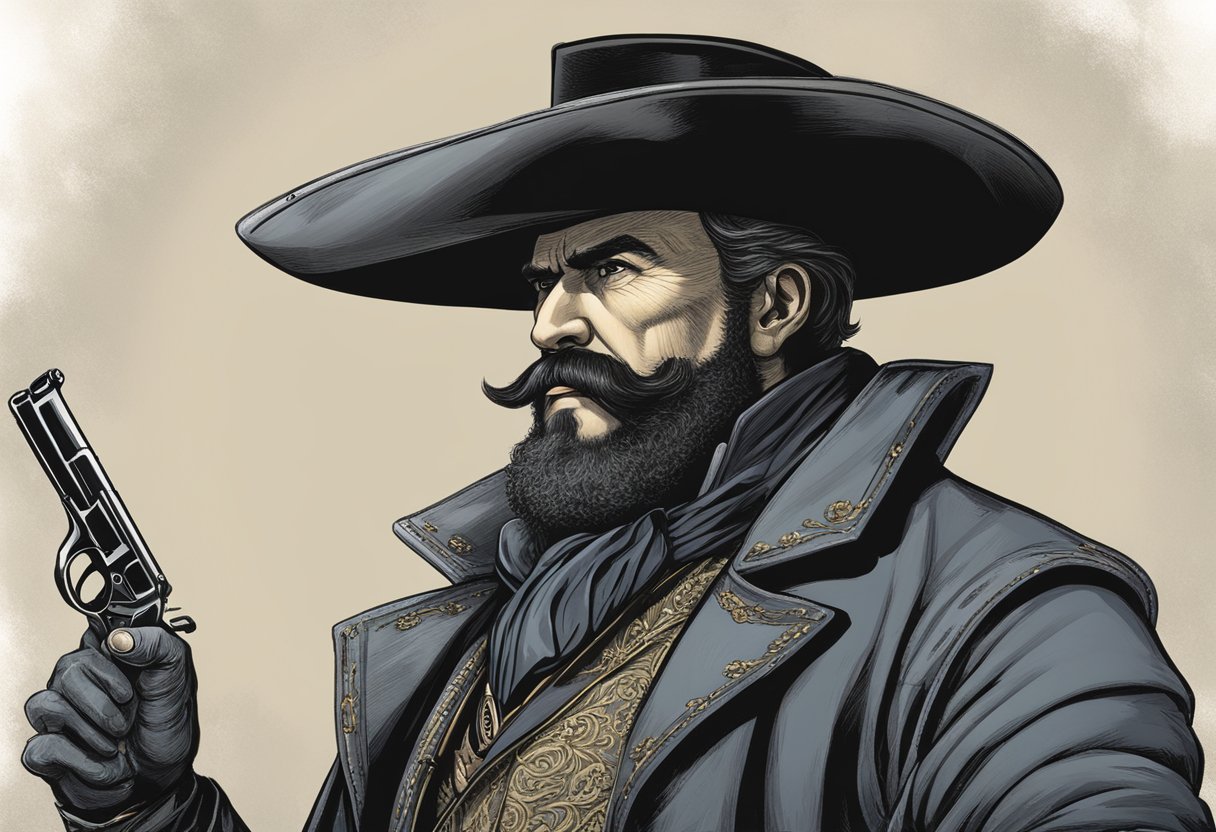Black Bart: The Poetic Bandit of the Wild West
Black Bart: The Notorious Pirate of the High Seas
Black Bart, also known as Charles Earl Boles, was an infamous American outlaw who gained notoriety during the late 1800s for his string of stagecoach robberies. He was known for his distinctive style, which included leaving behind poetic messages after his heists. Despite his criminal activities, Black Bart was often referred to as a “gentleman bandit” due to his polite demeanor and refined appearance.
Born in 1829, Black Bart’s early life is shrouded in mystery. He first gained national attention in the mid-1870s when he began robbing stagecoaches in California. Over the course of several years, he is believed to have robbed at least 28 stagecoaches, often leaving behind messages in verse. Despite the efforts of law enforcement, Black Bart managed to evade capture for many years, becoming one of the most notorious outlaws of his time.
Black Bart’s exploits have been the subject of numerous books and films, and his legacy continues to capture the imagination of people today. Despite his criminal activities, he is remembered for his unique style and the poetic messages he left behind, which have become a part of Wild West lore.
Black Bart: The Legend
Black Bart was an infamous stagecoach robber who operated in California during the late 1800s. He was known for his gentlemanly demeanor and his poetic notes that he left behind after each robbery. Despite being one of the most prolific stagecoach robbers of his time, Black Bart was never caught.
Origin of the Name
Black Bart was not his real name. He adopted the moniker after reading a book about the English poet Thomas Moore. In the book, there was a character named Black Bart who was a highwayman. Black Bart liked the name and decided to use it as his own.
Early Life
Black Bart was born Charles Boles in Norfolk, England, in 1829. He immigrated to the United States in the 1850s and settled in Illinois. He later moved to California during the gold rush and worked as a miner and a store clerk.
In 1864, Black Bart married Mary Elizabeth Johnson. They had four children together, but two of them died in infancy. Black Bart struggled to provide for his family and turned to a life of crime to make ends meet.
Despite his criminal activities, Black Bart was known for his polite demeanor and his love of literature. He was often seen reading books and reciting poetry, even while on the run from the law.
Black Bart: The Outlaw
Black Bart, whose real name was Charles Earl Boles, was a notorious outlaw in the Wild West known for his poetic messages and gentlemanly demeanor. He is believed to have robbed at least 28 stagecoaches from 1875 to 1883.
Notable Heists
One of Black Bart’s most notable heists occurred on July 26, 1878, when he robbed a stagecoach traveling from Point Arena to Duncan’s Mills, California. He left behind a poem that read:
I've labored long and hard for bread,
For honor and for riches,
But on my corns too long you've tread,
You fine-haired sons of b---s.
Black Bart’s last robbery was on November 3, 1883, when he held up a stagecoach traveling from Sonora to Milton, California. He left behind a poem that read:
So here I've stood while wind and rain
Have set the trees a-sobbin',
And risked my life for that d--n box
That wasn't worth the robbin'.
Modus Operandi
Black Bart’s modus operandi was to wait for a stagecoach to approach and then approach it on foot, disguised in a flour sack over his head. He would then demand the strongbox from the driver, take what he wanted, and leave behind a poem. Black Bart was known for his gentlemanly demeanor during his robberies, never harming anyone and always apologizing for the inconvenience he caused.
Despite his prolific crime spree, Black Bart was eventually caught and sentenced to six years in San Quentin State Prison. After serving four years, he was released for good behavior and disappeared from history.
Capture and Trial

Bartholomew “Black Bart” Roberts was a successful pirate who captured and looted more ships than any of his contemporaries in the so-called “Golden Age of Piracy”. However, his career came to an end when he was captured by the Royal Navy in 1722.
Roberts was aboard his ship, the Royal Fortune, off the coast of West Africa when he was surprised by the arrival of HMS Swallow. Despite being outnumbered and outgunned, Roberts refused to surrender and instead ordered his crew to prepare for battle. The ensuing fight was fierce, but ultimately the Royal Fortune was captured and Roberts was taken into custody.
After his capture, Roberts was taken to Cape Coast Castle in Ghana, where he was held in irons and put on trial for piracy. He was found guilty and sentenced to be hanged. Roberts was unrepentant, stating that “In an honest service there is thin commons, low wages, and hard labor; in this, plenty and satiety, pleasure and ease, liberty and power; and who would not balance creditor on this side, when all the hazard that is run for it, at worst, is only a sour look or two at choking. No, a merry life and a short one shall be my motto.”
Roberts was executed on February 10, 1722, and his body was thrown overboard. His crew was also captured and many of them were hanged alongside him.
Post Imprisonment Life

After serving just over four years in San Quentin prison, Black Bart was released on January 21, 1888. He reportedly moved to Harrisburg, Pennsylvania, where he lived a quiet life until his death in the early 1900s.
Despite his criminal past, Black Bart’s post-imprisonment life was largely uneventful. He did not return to a life of crime and instead focused on living a peaceful existence.
There are conflicting reports about what Black Bart did for a living after his release from prison. Some sources claim that he worked as a janitor or handyman, while others suggest that he may have worked in a mine or as a ranch hand.
Regardless of his occupation, it is clear that Black Bart never achieved the same level of notoriety as he did during his criminal career. He faded into obscurity, and his death went largely unnoticed by the public.
Despite his criminal past, Black Bart’s story remains a fascinating part of American history. His unique modus operandi and poetic messages left behind at crime scenes continue to capture the imagination of people today.
Legacy

Black Bart’s legacy as a pirate has endured long after his death. He is remembered as one of the most successful pirates of the Golden Age of Piracy, having captured and looted more ships than many of his contemporaries combined. He was known for his cunning tactics and his ability to outmaneuver his enemies.
Despite his short career as a pirate, Black Bart has been featured in numerous books, movies, and TV shows. He has become a popular figure in pirate lore, and his name has become synonymous with piracy.
In addition to his notoriety as a pirate, Black Bart has also left a legacy as a symbol of Welsh pride. He was born in Wales, and his Welsh heritage was an important part of his identity. Today, he is celebrated in Wales as a symbol of Welsh courage and defiance.
Overall, Black Bart’s legacy continues to fascinate and inspire people around the world. His story is a reminder of the power of determination and the allure of adventure, and it has captured the imaginations of generations of people.
In Popular Culture

Black Bart, the infamous bandit who terrorized stagecoaches in California in the late 1800s, has become a popular figure in books, movies, and TV shows. However, it is important to note that the depictions of Black Bart in these works are often based more on myth than historical fact.
In literature, Black Bart has been the subject of several books, including “Black Bart: Boulevardier Bandit” by George Hoeper and “Black Bart: The Poet Bandit” by Miriam Allen deFord. These books portray Black Bart as a gentleman bandit who robbed stagecoaches with style and flair. They also focus on his poetic messages that he left behind after each robbery, which have become his trademark.
In film and television, Black Bart has been portrayed in various ways. In the 1948 film “Black Bart,” he was played by Dan Duryea as a charming and suave outlaw. In the 1950s TV series “Death Valley Days,” he was portrayed as a more serious and menacing figure. In the 1975 TV movie “Black Bart,” he was played by Tom Skerritt as a romantic figure who falls in love with a woman he meets during one of his robberies.
Despite the many depictions of Black Bart in popular culture, it is important to remember that much of what we know about him is based on legend and myth rather than historical fact. Nevertheless, his legacy as a notorious bandit and poet continues to capture the imagination of people today.
As the lead author at People Epics, Hilary Chapman combines a passion for storytelling with a love of history, pop culture and psychology. With a background as a tour guide in historic places and a flair for uncovering fascinating tales, Hilary brings life to the stories of legendary figures and modern celebrities alike. Her engaging writing style invites readers to explore the intriguing connections between their lives and those of the famous personalities who have shaped our world.




